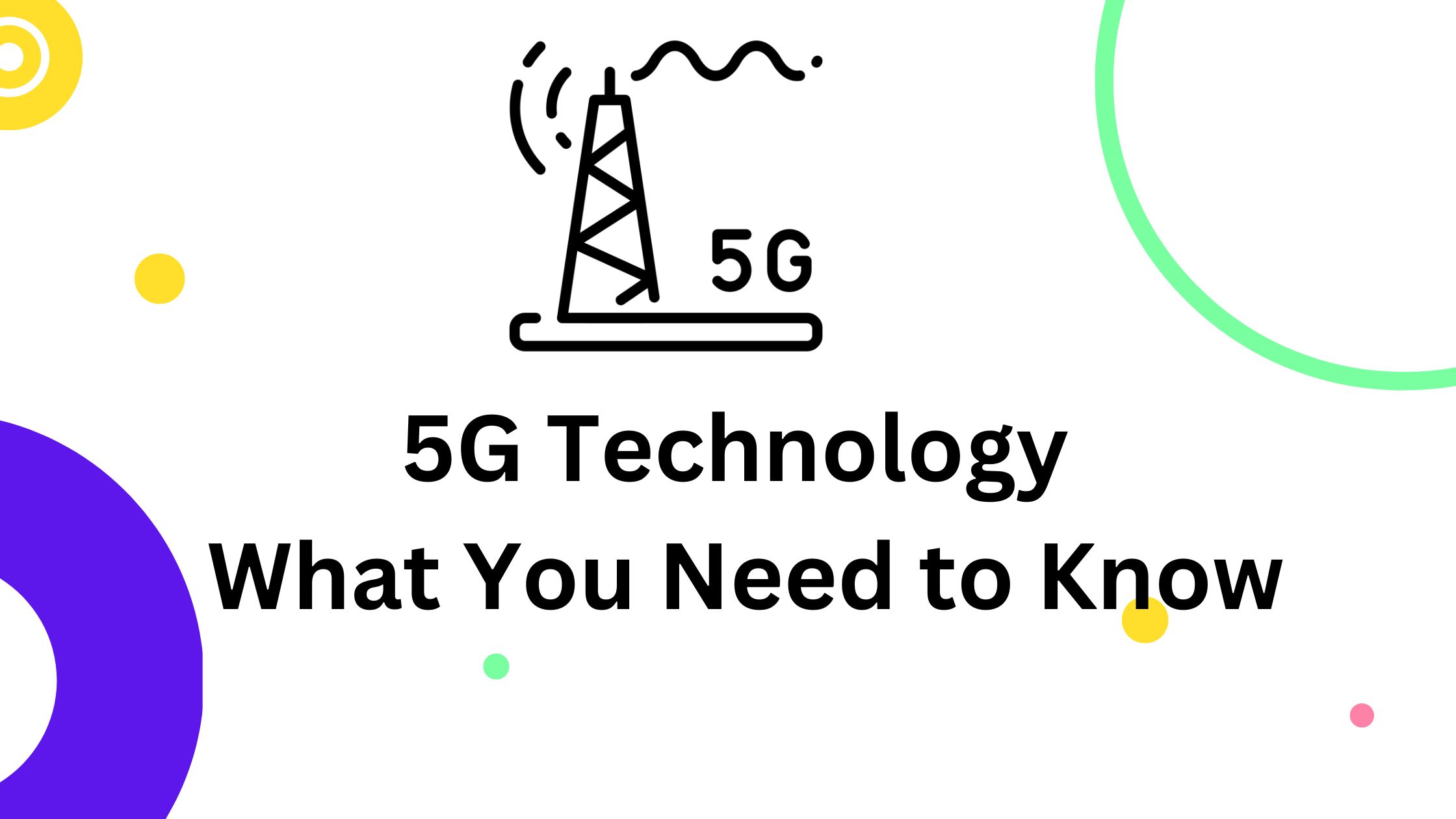5G technology is the fifth generation of cellular network technology that promises to revolutionize the way we connect to the internet and communicate with each other. With faster download and upload speeds, lower latency, and improved reliability, 5G has the potential to change the way we live and work. In this post, we will take a closer look at what 5G technology is, how it works, and what it means for the future.
What is 5G?
5G stands for “fifth generation” and refers to the latest iteration of cellular network technology. It follows in the footsteps of 1G, 2G, 3G, and 4G, each of which brought significant improvements in speed and connectivity. 5G builds on the foundation laid by its predecessors and takes it to a whole new level. 5G Technology
Increased Speed
The most significant improvement that 5G brings is increased speed. While 4G networks are capable of speeds of up to 100Mbps, 5G networks are capable of speeds of up to 10Gbps. This means that you will be able to download a full-length HD movie in just a few seconds, whereas on 4G it would take several minutes. This increased speed also means that 5G networks will be able to handle more data and more devices at the same time.
Low Latency
Another key feature of 5G is its low latency. Latency is the time it takes for data to travel from one device to another. With 5G, latency is expected to be as low as 1 ms, compared to 50ms on 4G networks. This means that 5G networks will be much more responsive, which is critical for applications like virtual reality and autonomous vehicles.
Improved Reliability
5G networks will also be more reliable than previous generations of cellular networks. This is because 5G networks will use a technique called beamforming, which allows the network to focus its signal on specific devices. This will help to reduce interference and improve overall network performance. 5G Technology
Applications
5G technology will enable a wide range of new applications that were not possible with previous generations of cellular networks. These include virtual reality, augmented reality, autonomous vehicles, smart cities, and the Internet of Things (IoT).
Who is developing 5G technology in India?
Several companies and organizations in India are working on the development and deployment of 5G technology. Some of the major players include:
- Bharat Sanchar Nigam Limited (BSNL): India’s state-owned telecommunications company is one of the major players in the development of 5G technology in the country. They are working to develop a 5G network and have conducted several successful trials. 5G Technology
- Reliance Jio: A leading Indian mobile network operator and digital service provider, Reliance Jio is actively working on the development and deployment of 5G technology in India.
- Ericsson: The Swedish multinational networking and telecommunications company Ericsson has a strong presence in India and is actively involved in the development and deployment of 5G technology in the country.
- Nokia: The Finnish multinational telecommunications, information technology, and consumer electronics company Nokia is also actively involved in the development and deployment of 5G technology in India.
- Huawei: Chinese multinational technology company Huawei is also participating in the development of 5G in India, it’s widely known for being a leading player in the 5G field.
- Samsung: The South Korean multinational electronics company Samsung is also actively involved in the development and deployment of 5G technology in India.
These are some of the major players, however, there are also other Indian and foreign companies and organizations that are working on the development and deployment of 5G technology in India.
Which technology is used in 5G?
5G technology utilizes a combination of several different technologies to provide faster speeds, lower latency, and improved reliability. Some of the key technologies used in 5G include:
- Millimetre wave (mmWave) technology: This technology uses high-frequency radio waves in the millimetre range to transmit data. These waves have a shorter wavelength and can carry more data than traditional cellular frequencies, which allows for faster speeds.
- Massive MIMO (Multiple Input Multiple Output): This technology uses a large number of antennas at the base station to simultaneously transmit and receive multiple data streams. This improves the overall capacity and coverage of the network.
- Beamforming: This technology uses advanced signal processing to focus the transmission of radio waves in a specific direction. This helps to reduce interference and improve the overall performance of the network.
- Small cells: 5G networks will also use a large number of small cell sites, which are low-power base stations that can be placed in a variety of locations, such as on street lamps or buildings. This will improve the overall coverage and capacity of the network.
- Network slicing: This technology allows for the creation of multiple virtual networks within a single physical network. This will enable different types of services and applications to be run on the same network while ensuring that they don’t interfere with each other.
- Orthogonal frequency-division multiplexing (OFDM): It’s a multi-carrier modulation technique that uses a large number of closely spaced subcarriers to transmit data. This enables more efficient use of the available bandwidth and improves the resilience of the network to interference.
- Non-Orthogonal Multiple Access (NOMA): This is a multiple-access technique that allows multiple users to share the same frequency band simultaneously. This improves the overall capacity of the network and enables more efficient use of the available spectrum.
What is 5G frequency?
5G networks operate on a wide range of frequencies, including both sub-6GHz and mmWave frequencies.
The sub-6GHz frequencies used for 5G include frequencies in the range of 600 MHz to 6 GHz, these frequencies are similar to the ones used for 4G networks and provide a wider coverage area.
The mmWave frequencies used for 5G include frequencies in the range of 24 GHz to 100 GHz, these frequencies are higher than the ones used for previous generations and provide faster speeds and lower latency, but have a more limited coverage area.
Additionally, there are also mid-band 5G frequencies in the range between sub-6GHz and mmWave, which provide a balance of coverage and speed.
The exact frequencies used for 5G will vary depending on the region and the specific spectrum allocation by the government.
What are the 3 types of 5G?
There are three main types of 5G networks:
- Sub-6GHz 5G: This type of 5G network uses frequencies below 6GHz, which provides a wider coverage area and better penetration through walls and other obstacles. Sub-6GHz 5G is often referred to as “low-band 5G.”
- mmWave 5G: This type of 5G network uses frequencies above 24GHz, which provide faster speeds and lower latency but have a limited coverage area. mmWave 5G is often referred to as “high-band 5G.”
- Mid-band 5G: This type of 5G network uses frequencies between the sub-6GHz and mmWave spectrum, providing a balance of coverage and speed. It is also considered a “mid-band 5G”.
All three types of 5G are expected to be used together to provide a comprehensive 5G network experience.
Which 5G band is the fastest?
The fastest 5G bands are the mmWave bands, which operate at frequencies above 24GHz. These bands provide the fastest speeds and lowest latencies of all 5G bands. The high frequency of these bands allows for more bandwidth and greater capacity, which results in faster data transfer speeds. The downside is that the signal does not travel as far and does not penetrate through walls and other obstacles as well as lower frequency bands like sub-6GHz.
Also Read This: Everything You Need to Know About 5G
That being said, the actual speed of a 5G network will depend on various factors such as network congestion, device capabilities, and network infrastructure. It’s important to note that while mmWave bands are capable of faster speeds, they are currently more limited in terms of coverage area compared to sub-6GHz bands.
5G Technology Challenges and Future
5G technology is still in its early stages and there are still many challenges to be overcome. One of the biggest challenges is the cost of deploying 5G networks, as well as the need to upgrade existing infrastructure. Additionally, there are concerns about the potential health risks of 5G radiation. Despite these challenges, the future of 5G technology looks bright, and it is poised to play a major role in shaping the way we live and work in the years to come.
What are the major challenges of 5G?
Some major challenges of 5G include:
- Interference: 5G networks operate on a wider range of frequencies than previous generations, which can make them more susceptible to interference from other wireless devices and systems.
- Security: As 5G networks become more widely adopted, they will become a more attractive target for cyberattacks. Ensuring the security of 5G networks and the devices that connect to them will be a major challenge.
- Network Coverage: Building out the infrastructure to support 5G networks, especially in rural and remote areas, will be a significant challenge.
- Backward Compatibility: Ensuring that 5G networks are backwards compatible with 4G and 3G networks, so that older devices can still connect to the network, will be a significant challenge.
- Energy consumption: 5G networks require more energy to operate than previous generations, which can be a major challenge.
What are the negative aspects of 5G?
While 5G technology brings many benefits, there are also some negative aspects to consider:
- Health concerns: Some people are concerned about the potential health effects of prolonged exposure to the higher frequency radio waves used in 5G networks. However, multiple studies and organizations including the World Health Organization (WHO) have stated that 5G technology is safe and that radio frequency emissions are not harmful to human health.
- Interference with weather forecasting: 5G networks operate on some of the same frequencies as weather radar, which could interfere with the accuracy of weather forecasting.
- Security risks: 5G networks may be more vulnerable to cyber attacks due to the increased amount of connected devices and the fact that 5G networks are built on new infrastructure.
- Cost: Building out the infrastructure for 5G networks, especially in rural and remote areas, can be very expensive. Additionally, 5G-enabled devices are generally more expensive than their 4G counterparts.
- Energy consumption: 5G networks require more energy to operate than previous generations. Which can be a major challenge, especially in terms of sustainable development.
Also Read: The Future of Artificial Intelligence
Is 5G a threat to privacy?
There is currently an ongoing debate about the potential privacy risks associated with 5G technology. Some experts argue that the increased data speeds and connectivity of 5G networks could make it easier for hackers to access personal information, while others argue that 5G networks will have the same or similar security measures as current cellular networks and that any risks can be managed through proper security protocols and regulations. It’s important to note that 5G itself is not a threat to privacy but the increased data collection and sharing that comes with it may pose a threat to the privacy of individuals.
Conclusion In conclusion, 5G technology is the next step in the evolution of cellular networks. With faster speeds, low latency, and improved reliability, 5G has the potential to change the way we live and work. While it is still in its early stages, 5G technology is set to play a major role in shaping the future of communication and technology.



